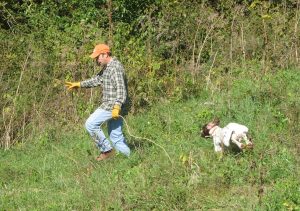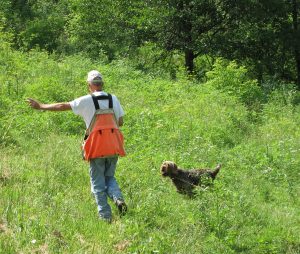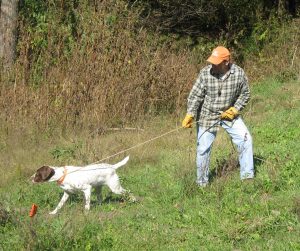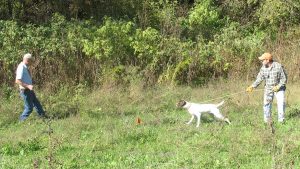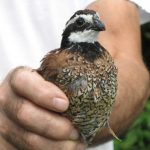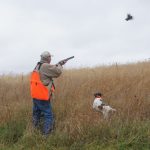POINTING DOG POINTERS: Starting the Pointing Dog Pup – Handling in the Field
By Bob and Jody Iler
Congratulations – you’ve got a pointing dog pup that is birdy! He’s searching for and finding the birds, possibly pointing, and is chasing with enthusiasm at the flush. He may be “busting birds” at this stage of development, which is OK for now. The bottom line is that your pup’s introduction to birds has hopefully made him just plain all-around bird crazy.
We always say that we want our young pup pulling us to the field! We don’t want him heeling meekly at our side. We don’t want his tail down or between his legs. We don’t want him lagging behind us. Rather, we want him alive with excitement, tail waving, even trembling at the prospect of getting out in the field. And so – that first month of bird introduction for your pup has held little in the way of any control work or training. The pup is similar to a young child who is learning a skill; we don’t want to inhibit the child’s growth, effort, and imagination by setting too many boundaries and control. Likewise, you’ve tried to let your pup have his head during his bird work, focusing only on developing his love of birds.
If your pup has turned on fast to the bird work, you may have let him drag a checkcord and had to use it for a little control now and then. If your pup was a bit soft or reserved, you let him have his head, fostering his excitement for birds and not worrying about control. Remember, if pup isn’t excited about birds, full of zest and drive, there isn’t much to control!
Quartering Without Birds in the Field
To begin teaching control in the field, we start with quartering. Quartering will teach pup to start paying attention to you. You’ll need a nylon or chain slip collar and a checkcord no longer than 20 feet. If your pup is soft, it may be enough to use a regular flat collar instead of a slip collar, as we want to keep things positive and not intimidate the pup. You can work on quartering practice in any large grassy area or field where you can walk in a forward direction for a good distance. For initial lessons, we don’t want to practice quartering with any birds around.
Start out by walking forward into the field with your pup. As she bounds ahead of you, begin to walk in a zig zag pattern, moving from left to right in a sweeping, wide motion. As you head to the left, your pup may be running in the opposite direction and will not be paying attention as you turn. She’ll hit the end of the checkcord in surprise. Keep walking to the left as she, too, changes her direction to yours. Then, after a few minutes going left, reverse your direction and head to the right. Again, the checkcord will alert her to pay attention. As she sees you move in the opposite direction, she’ll turn and head in that direction too.
You want to keep quiet during this exercise. Your goal is to get pup to pay attention to where you are going without using your voice. You’ll be surprised how quickly pup will get the hang of this. If she pulls at the checkcord and starts to go her own way, reverse your current direction and make sure she gets a “pop” correction from the checkcord as you do. Soon you’ll notice pup starting to check back visually with you to see which way you’re headed. Once she starts doing this, you can add a sweeping hand motion – either to the left or the right – each time you make your zig zag turns. In time, as field training progresses successfully, you can add a whistle call to the hand signal as you change direction and make your checkcord correction. Make this whistle call specific (we use a bobwhite call – “toooo-whit!”) and do not overdo it.
It’s important to be gentle with this training, especially with soft pups. You want to keep fostering your pup’s confidence even as you begin to establish the bond of working together as a team.
Quartering With Birds in the Field
Once you’re sure that your pup understands the quartering process and is paying attention to you, you can continue this training in a field where you have one or two birds planted ahead of time. Plant the birds a distance away so you can practice quartering as you approach the birds. When your pup scents the first bird, she may or may not point, but either way it’s all right to let her break and chase without restraint as the bird flushes.
When we initially add birds to the quartering training, we want to keep pup’s confidence and excitement going by letting her chase. Adding control in the field is a process that is always guided by each individual pup’s response. A shy or soft pup will need less control and more sweet talk and praise to motivate him. Too much control can shut this type of pup down. A bold pup will need more control and plenty of quartering sessions to remind him that he’s learning to work as your partner in the field.
Pointing dogs are naturally going to get out and explore the birdy objectives as they develop. This means that they won’t always be quartering in front of you as a retriever might do. The purpose behind teaching them to quarter is that when your young dog is out there hunting, a toot on your whistle and gesture of your arm will alert her to where you are so she will respond accordingly.
Restraining Pup From Chasing the Bird
Your pup should now be paying attention to where you are going in the field and responding well in your quartering sessions. Pup should also be excited when scenting and finding birds, giving chase with exuberance.
Once you reach this stage, it’s time to start lightly restraining your pup from chasing the bird once it flushes. When possible, you’ll also want to restrain pup from catching a bird now – too much of this will soften his pointing instinct. If pup has been pointing or flash pointing and then breaking to “jump in,” gently restrain him with the checkcord from jumping in or chasing the bird. You’re not trying to steady him to wing and shot at this young age – you’re simply beginning to establish another form of control.
If your pup is still not pointing, it’s all right to gently restrain him when he’s made scent and starts to move toward the bird to flush it on his own. Sometimes this will also help the pup to be more cautious and he may start to point.
As you progress in these sessions, it’s often helpful to have a training partner to flush the planted birds as you gently restrain the pup.
Using the Here (Come) Command
Here is a key command for your dog in the field. You’ll want him to come to you when called without fail as he matures. We let this command rest in the background a bit as we light the fire for birds within him in the first month or so, and even as we fan the flames and add the quartering work in the next few weeks. But once we have a bird-crazy pup on our hands, it’s time to start practicing the here command. Like quartering, it’s best to begin this exercise in a big yard or field without birds.
Let the pup range out and explore as you walk forward in the field or yard. Let the slack in the checkcord play out until it’s nearly taut. Once he’s not paying attention to you, pop the checkcord and at the same instant call, “Here.” Back up and guide the pup to you as you do so. You can pop the checkcord once or twice more for emphasis as he comes to you. This command should be given with authority, but made to be positive and fun. Clap your hands, sound excited, and be liberal with praise. But at the same time, firmly insist that your pup come right back to you every time.
We don’t want to overuse this command during the initial started dog program. It can have the unwanted effect of drawing the pup in close and limiting his drive for exploring and hunting in the field. A few practice sessions without birds during the week and once or twice in a field session with birds is sufficient at this stage.
Remember, control can always be added, but too much control too soon can set your pup back. It’s easier to avoid creating a problem than trying to fix it later. Be fair, be gentle, and be appropriate with your control work – always reading what your pup is telling you by his responses!
Pointing Dog Pointers features monthly training tips by Bob and Jody Iler, who own Green Valley Kennels in Dubuque, Iowa. Bob and Jody have trained pointing dogs for over 35 years and have written many articles for Pointing Dog Journal.



